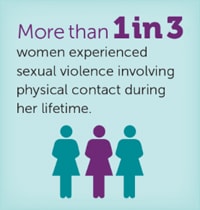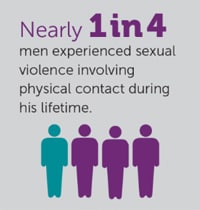Sexual Violence is Preventable

What is sexual violence?
Sexual violence (SV) refers to sexual activity when consent in not obtained or not freely given. SV impacts every community and affects people of all genders, sexual orientations, and ages. Anyone can experience SV, but most victims are female.
SV affects millions of people each year in the United States. The official numbers are likely an underestimate because many cases go unreported. Victims may be ashamed, embarrassed, or afraid to tell the police, friends, or family about the violence.
April Is National Sexual Assault Awareness Month!
Facts About Sexual Violence

Women
- Nearly 1 in 5 women have experienced completed or attempted rape during her lifetime.
- 1 in 3 female rape victims experienced it for the first time between 11-17 years old.
- 1 in 8 female rape victims reported that it occurred before age 10.

Men
- Nearly 1 in 38 men have experienced completed or attempted rape during his lifetime.
- About 1 in 4 male rape victims experienced it for the first time between 11-17 years old.
- About 1 in 4 male rape victims reported that it occurred before age 10.
Child Sexual Abuse
When SV involves a victim less than 18 years old, it is child sexual abuse. Child sexual abuse (CSA) refers to the involvement of child in sexual activity that he/she:
- does not fully comprehend
- does not consent to or is unable to give informed consent to, or
- is not developmentally prepared for and cannot give consent to
Experiencing child sexual abuse is an adverse childhood experience (ACE) that can affect how a person thinks, acts, and feels over a lifetime, resulting in short- and long-term physical and mental/emotional health consequences.

For more information about child sexual abuse, please see Preventing Child Sexual Abuse.
Sex Trafficking
SV also includes sex trafficking. Sex trafficking is a type of human trafficking and is a form of modern day slavery. Sex trafficking involves the use of force, fraud, or coercion to make an adult engage in commercial sex acts. Please see the Trafficking Victims Protection Act of 2000 for the full definition of sex trafficking.
- Victims include people of all races, ethnicities, sexual orientations, gender identities, countries of origin, and income levels.
- Victims are trapped and controlled through assault, threats, false promises, perceived sense of protection, isolation, shaming, and debt.
- Victims do not have to be physically transported between locations to be victimized.
Learn how to recognize the signs of human trafficking by visiting the National Human Trafficking Hotline’s Recognizing the Signs website.
If you or someone you know is being trafficked, contact the National Human Trafficking Resource Center.
- Call 1-888-373-7888 (TTY: 711) Text 233733
Prevention is Possible
SV impacts health in many ways and can lead to short and long-term physical and mental health problems. This is why CDC focuses on preventing SV before it happens. Changing social norms, teaching skills, empowering girls and women, and creating protective environments can help reduce SV. We all have a role to play in prevention.

Parents, school staff, other caring adults can:
- Teach skills to prevent SV.
- Help youth build positive communication skills, including conflict resolution and how to handle emotions in a healthy way.
- Practice and model healthy, safe dating and intimate relationships in order to teach youth dating and relationship skills.
- Check out CDC’s Dating Matters: Strategies to Promote Healthy Teen Relationships. There are parent programs as well as a training for educators.
- Promote healthy sexuality by discussing topics like sexual behavior, sexual communication, respect, and consent.
Schools and workplaces can:
- Create protective environments.
- Improve safety and monitoring in schools by addressing areas where students feel less safe, identifying safe spaces and staff support for students, and create an atmosphere of intolerance for harassment and violence.
- Establish and apply proactive workplace sexual harassment prevention policies and procedures that include commitment from top management, zero tolerance, notification to applicants and new hires of harassment-free environments, regular organizational assessments, and consistent, specific training to reduce workplace SV behaviors.

Everyone can:
- Promote social norms that protect against violence.
- Speak up against sexist language or behaviors that promote violence.
- Offer to help or support in situations where violence may occur or has occurred
- Support Survivors to Lessen Harms.
- Know where and how to get help.
- Victim-centered services like rape crisis centers provide a safe, healing environment where survivors can access resources and victim advocacy.
- Evidence-based treatments, like Trauma-focused Cognitive Behavioral Therapy (TF-CBT), can help victims address the negative effects of SV, such as depression, anxiety, and post-traumatic stress disorder (PTSD).
- Treatment for children who may have been exposed to violence in the home or community and are at-risk for violence perpetration or other serious behavioral problems is available. One example is the Children with Problematic Sexual Behavior Cognitive-Behavioral Treatment Program: School-Age Program (PSB-CBT), which is meant to reduce or eliminate sexual behavior problems.
- If you are or someone you know is a survivor of SV:
- Contact the Rape, Abuse, and Incest National Network (RAINN) hotline at 1-800-656-HOPE. Help is free, confidential, and available 24/7. Get information at RAINN.
- Contact your local emergency services at 9-1-1.
- Check out the National Sexual Violence Resource Center’s (NSVRC) Resources for specific audiences:
- Know where and how to get help.
Resources
CDC’s Sexual Violence Prevention Resources
CDC’s webpage that contains sexual violence prevention resources.
CDC’s webpage that contains sexual violence prevention resources.
CDC’s Dating Matters®: Strategies to Promote Healthy Teen Relationships
Dating Matters is a teen dating violence prevention model to stop teen dating violence before it starts.
Dating Matters is a teen dating violence prevention model to stop teen dating violence before it starts.
Raliance
Raliance is a collaborative initiative dedicated to ending SV and is a resource for policymakers, advocates, service providers, prevention practitioners, and the media.
Raliance is a collaborative initiative dedicated to ending SV and is a resource for policymakers, advocates, service providers, prevention practitioners, and the media.
National Domestic Violence Hotline
Call 1-800-799-7233 and TTY 1-800-787-3224.
Call 1-800-799-7233 and TTY 1-800-787-3224.
Love Is Respect National Teen Dating Abuse Helpline
Call 1-866-331-9474 or TTY 1-866-331-8453.
Call 1-866-331-9474 or TTY 1-866-331-8453.
Strong Hearts Native Helpline
Call 1−844-762-8483.
Call 1−844-762-8483.






















.png)











No hay comentarios:
Publicar un comentario